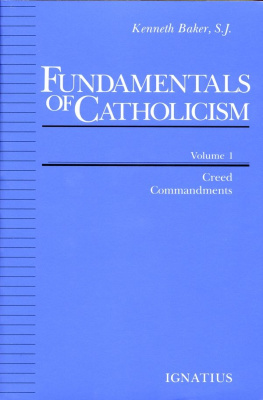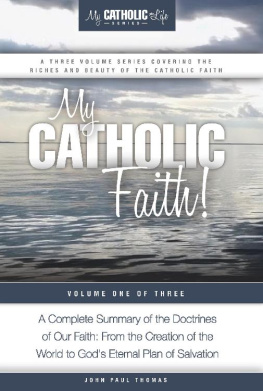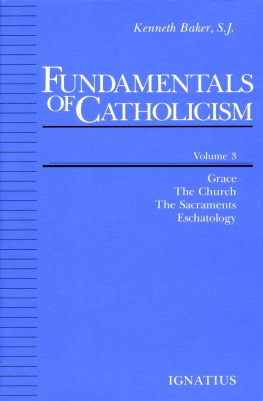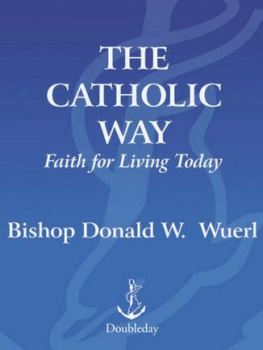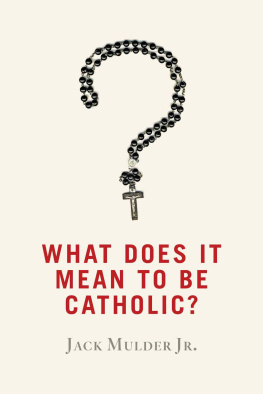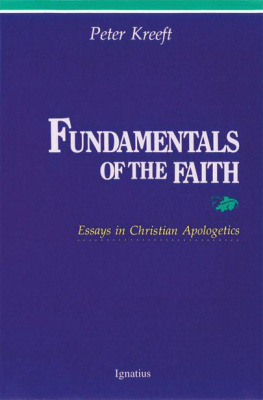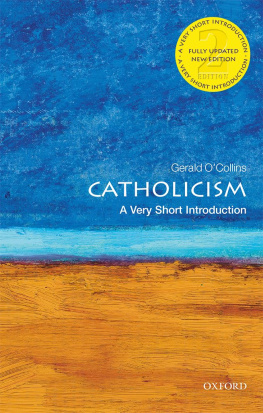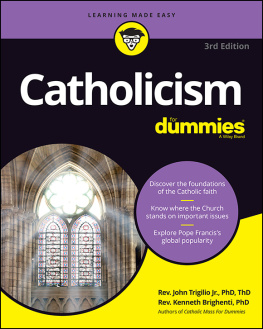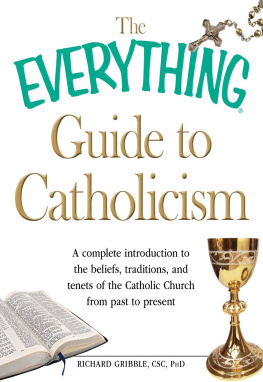FUNDAMENTALS OF CATHOLICISM
FUNDAMENTALS
OF
CATHOLICISM
by
KENNETH BAKER, SJ.
IGNATIUS PRESS SAN FRANCISCO
Imprimi Potest: Thomas R. Royce, S.J.
Provincial, Oregon Province
of the Society of Jesus
Portland, Oregon
Imprimatur: + Thomas J. Welsh
Bishop of Arlington, Virginia
Cover design by Riz Boncan Marsella
Fifth printing, 1995
1982 Kenneth Baker, S.J.
All rights reserved
ISBN 978-0-89870-017-6 (PB)
ISBN 978-1-68149-731-0 (EB)
Library of Congress catalogue number 82-80297
Co-published by Ignatius Press, San Francisco
and Homiletic & Pastoral Review
86 Riverside Drive, New York, N.Y. 10024
Printed in the United States of America
CONTENTS
PREFACE
Confusion is an apt word to describe the intellectual climate of our time. This is true, in my view, not only of Western culture in general, but also of the thinking of very many Catholicsin Europe, in North America and in South America.
While teaching a college course a few years ago on the fundamentals of the Catholic faith to about forty students, I came to the realization that over ninety percent of them did not understand the most basic tenets of their Catholic faith. Subsequently I suggested in a few short articles that we needed something like Remedial Catholicism in our colleges and universities, just as we offer remedial courses in English and mathematics.
Gradually I came to the realization that there should be more teaching and preaching about the basics of Catholicism. About that time Charles W. Carruth, editor of the Arlington Catholic Herald , Arlington, Virginia, asked me to begin writing a series of columns for the diocesan newspaper. First, I secured permission from Twin Circle to reprint a series on the Creed that I had written a few years before. When they were almost exhausted, I decided to complement them with a series on the moral teachings of the Church by taking each of the Ten Commandments. Those articles compose Volume I of this series.
After completing the scries on the Ten Commandments, it seemed to me good to work my way through the entire body of doctrinal teaching of the Catholic faith. Those articles, which appeared in the Herald over a period of about four years, cover the following doctrinal areas: in Volume II you will find the treatment of God, Trinity, Creation, Christ and Mary; in Volume III you will find the treatment of Grace, Church, Seven Sacraments and Eschatology or the Last Things.
What I have tried to do in these short articles is to present faithfully the traditional Catholic teaching on all the important points of doctrine and morals.
Who were these articles written for? They were written primarily for ordinary Catholic lay men and women who are looking for some direction in the present sea of confusion, and who would like to know more about the Catholic faith that they profess. I have covered all the basic theses of Catholic theology and have tried to express them in non-technical language, as far as this was possible.
The original purpose of the articles, therefore, was to help concerned Catholics reach a deeper understanding of their faith. But it seems to me that they could rightly be given to non-Catholics who are seriously interested in Catholicism. These volumes can help the non-Catholic understand the Catholic faith betterand perhaps even come to embrace it. Also, because of the nature of the short essays, they might be used by priests as the basis of simple sermons on the essentials of the faith.
These articles did not just come out of my head. They are based on the traditional treatises of theology that all priests study in the seminary. I am indebted, therefore, to my professors in the seminary and to many books that I have consulted in the course of writing these essays. The books that I have relied on primarily for guidance are the following:
Holy Bible
Enchiridion Symbolorum , Denzinger-Schoenmetzer
Fundamentals of Catholic Dogma , Ludwig Ott
Summa Theologica , Thomas Aquinas
Summa Contra Gentiles , Thomas Aquinas
New Catholic Encyclopedia
The Catholic Catechism , John A. Hardon, SJ.
The Teaching of Christ , Ronald Lawler et al .
Dictionary of Theology , Louis Bouyer
Documents of Vatican II , Walter M. Abbott, S.J., Editor
I wish to thank first of all Charles W. Carruth for his help and encouragement. It was due to him that all of these articles appeared in the Arlington Catholic Herald as a weekly column, beginning in January 1976. My thanks go also in a special way to Most Reverend Thomas J. Welsh, Bishop of Arlington, who read the articles in his own newspaper and kindly consented to write the Introduction to these volumes. Finally, I want to thank Fr. Joseph Fessio, S.J., and his devoted collaborators at Ignatius Press for their diligence and patience in the production of these three volumes.
It is my earnest hope and prayer that these short essays on the fundamentals of Catholic faith will assist manyboth Catholics and non-Catholicsto acquire a better understanding of the inexhaustible treasure of Catholic truth. With the help of Gods grace, understanding should lead to love, love to acceptance, and acceptance to fearless Christian living in our age of confusion. For, nothing is more effective in rooting out the darkness of error and confusion than the brilliant white light of Catholic truth.
KENNETH BAKER, S.J.
October 15, 1981
Feast of St. Teresa of Avila
New York, N.Y.
INTRODUCTION
Pilgrims to the Shrine of Lourdes in France close their day of prayer with a torchlight procession that begins near the Grotto and winds along the walkways to circle back and end in front of the Basilica. All the while in languages from around the world they sing over and over again the Lourdes Hymn, this group or that one, leading the verses in French or Italian or Polish and everyone joining in the refrain. When, finally, all are close together in front of the church, they chant in Latin the Gregorian Creed. It is an inspirational moment that reminds all present of their one faith. I thank Fr. Kenneth Baker for beginning this three-volume work by a beautiful series of articles on the Creed. They reminded me of that faith experience at Lourdes and pointed up the special quality of his writing.
To know, love and serve God. That was a simple and easily memorized formula of yesteryear. This work of Fr. Baker speaks in the same arresting simplicity and rewards the persistent prober in the same way.
If one asks the question: is there need today for a straightforward series on the fundamentals of faith, an easy answer would be that there must be since Pope John Paul II has been so often busy about that very thing. When he visited the United States in October 1979 he spoke to the bishops at length about fundamentals. He congratulated them on their teachings in defense of life, on indissolubility of marriage, on celibacy, on morality. His encyclicals have stressed the fundamentals that Christ is the Redeemer of mankind and that God is rich in mercy. His message in Mexico was that there can be no real approach to the solution of the problems of mankind unless we first understand who God is. Everywhere the large M for Mary on his coat of arms points to him kneeling in prayer at Marys shrine in Czestochowa, Knock, Loreto and Guadalupe. Only a would-be assassins bullets kept him from Lourdes. He knows that the law of praying and the law of faith are one. His fundamental prayer literally around the world has been to Mary, Mother of God and Mother of the Church.
But let us not approach the question backwards: there is not a need to stress fundamentals because the Pope is doing it. Rather, the Vicar of Christ is doing it because there is the need!
Next page
